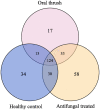Candida species and oral mycobiota of patients clinically diagnosed with oral thrush
- PMID: 37068057
- PMCID: PMC10109505
- DOI: 10.1371/journal.pone.0284043
Candida species and oral mycobiota of patients clinically diagnosed with oral thrush
Abstract
Overgrowth of Candida yeasts in the oral cavity may result in the development of oral thrush in immunocompromised individuals. This study analyzed the diversity and richness of the oral mycobiota of patients clinically diagnosed with oral thrush (OT), follow-up of oral thrush patients after antifungal therapy (AT), and healthy controls (HC). Oral rinse and oral swab samples were collected from 38 OT patients, 21 AT patients, and 41 healthy individuals (HC). Pellet from the oral rinse and oral swab were used for the isolation of oral Candida yeasts on Brilliance Candida Agar followed by molecular speciation. ITS1 amplicon sequencing using Illumina MiSeq was performed on DNA extracted from the oral rinse pellet of 16 OT, 7 AT, and 7 HC oral rinse samples. Trimmed sequence data were taxonomically grouped and analyzed using the CLC Microbial Genomics Module workflow. Candida yeasts were isolated at significantly higher rates from oral rinse and swab samples of OT (68.4%, p < 0.001) and AT (61.9%, p = 0.012) patients, as compared to HC (26.8%). Predominance of Candida albicans specifically, was noted in OT (60.5%, p < 0.001) and AT (42.9%, p = 0.006) vs. HC (9.8%), while non-albicans Candida species was dominant in HC. Analysis of oral mycobiota from OT patients showed the presence of 8 phyla, 222 genera, and 309 fungal species. Low alpha diversity (Shannon index, p = 0.006; Chao-1 biased corrected index, p = 0.01), varied beta diversity (Bray-Curtis, p = 0.01986; Jaccard, p = 0.02766; Weighted UniFrac, p = 0.00528), and increased relative abundance of C. albicans (p = 3.18E-02) was significantly associated with the oral mycobiota of OT vs. HC. This study supported that C. albicans is the main etiological agent in oral thrush and highlights the association of fungal biodiversity with the pathophysiology of oral thrush.
Copyright: © 2023 Karajacob et al. This is an open access article distributed under the terms of the Creative Commons Attribution License, which permits unrestricted use, distribution, and reproduction in any medium, provided the original author and source are credited.
Conflict of interest statement
The authors have declared that no competing interests exist.
Figures





Similar articles
-
Neonatal thrush of newborns: Oral candidiasis?Clin Exp Dent Res. 2019 Jul 21;5(5):580-582. doi: 10.1002/cre2.213. eCollection 2019 Oct. Clin Exp Dent Res. 2019. PMID: 31687193 Free PMC article.
-
Colony morphologies, species, and biotypes of yeasts from thrush and denture stomatitis.Acta Odontol Scand. 2009;67(4):248-55. doi: 10.1080/00016350902992602. Acta Odontol Scand. 2009. PMID: 19479451
-
A sensitive and a rapid multiplex polymerase chain reaction for the identification of Candida species in concentrated oral rinse specimens in patients with diabetes.Acta Odontol Scand. 2017 Mar;75(2):113-122. doi: 10.1080/00016357.2016.1265146. Epub 2016 Dec 14. Acta Odontol Scand. 2017. PMID: 27960572
-
Revisiting oral thrush in South-East Asian patients: A review of published studies (2000-2020).J Oral Pathol Med. 2022 Jan;51(1):98-105. doi: 10.1111/jop.13266. Epub 2021 Dec 30. J Oral Pathol Med. 2022. PMID: 34859509 Review.
-
Oral mycology.Acta Odontol Scand. 1990 Feb;48(1):3-10. doi: 10.3109/00016359009012728. Acta Odontol Scand. 1990. PMID: 2181808 Review.
Cited by
-
Anticandidal Activity of Various Probiotic Lactobacillus Strains and Their Efficacy Enhanced by Prebiotic Supplementation.Curr Microbiol. 2024 Jul 16;81(9):271. doi: 10.1007/s00284-024-03800-y. Curr Microbiol. 2024. PMID: 39012492
-
Oral Mycobiota: A Narrative Review.Dent J (Basel). 2024 Apr 19;12(4):115. doi: 10.3390/dj12040115. Dent J (Basel). 2024. PMID: 38668027 Free PMC article. Review.
-
Fluconazole-Loaded Ibuprofen In Situ Gel-Based Oral Spray for Oropharyngeal Candidiasis Treatment.AAPS PharmSciTech. 2024 Apr 19;25(5):89. doi: 10.1208/s12249-024-02804-y. AAPS PharmSciTech. 2024. PMID: 38641711
-
Evaluation of the Disinfection Efficacy of Er: YAG Laser Light on Single-Species Candida Biofilms-An In Vitro Study.Dent J (Basel). 2025 Feb 19;13(2):88. doi: 10.3390/dj13020088. Dent J (Basel). 2025. PMID: 39996962 Free PMC article.
-
Acridine Derivatives as Antifungal and Antivirulence Agents Against Candida albicans.Int J Mol Sci. 2025 Jul 25;26(15):7228. doi: 10.3390/ijms26157228. Int J Mol Sci. 2025. PMID: 40806361 Free PMC article.
References
-
- Taylor M, Brizuela M, Raja A. Oral candidiasis. [Updated 2022 Sep 12]. In: StatPearls [Internet]. Treasure Island (FL): StatPearls Publishing; 2022. [cited 2022 Sep 15]. https://pubmed.ncbi.nlm.nih.gov/31424866/
Publication types
MeSH terms
Substances
LinkOut - more resources
Full Text Sources

